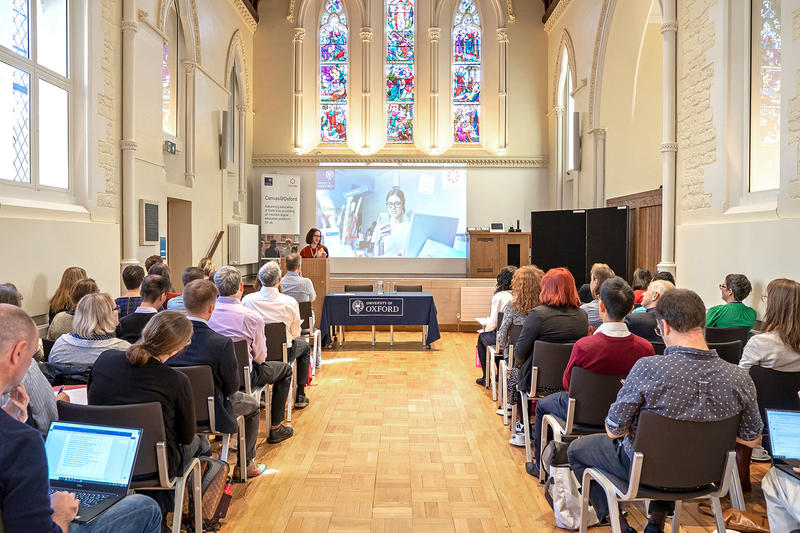
Kate Lindsay, former head of the Technology Enhanced Learning team, presenting the Canvas vision.
Photo by Michael P. Sannwald.
When Canvas was chosen in March 2018 as the virtual learning environment (VLE) to replace WebLearn for teaching and learning, the University was clear it didn’t just want to replace one set of technology for another. We wanted to start and sustain a conversation about the role that a VLE could play in supporting, exploring and enhancing teaching practice. Key to that conversation is how Canvas supports a number of the University’s important strategic objectives.
The stated vision of the Canvas @ Oxford programme is to ‘advance education at Oxford by providing an intuitive digital platform for academics, students, and staff’. Kate Lindsey, former head of Technology Enhanced Learning, had previously addressed the vision statement to explain the ‘education first’ approach of the new VLE, and as we move towards rolling out Canvas more widely across the University in time for Michaelmas term 2019, this is a good point at which to remind ourselves of some of the reasons why the University is making a major investment in time and resources in the change.
The VLE had its inception in the 2016 Digital Education Strategy, the goal of which is to ensure that in 2020 Oxford remains a premier institution for teaching, adopting the very best of teaching innovations that are made possible by digital technology. Since August 2018 Canvas early adopters have been using the VLE to deliver on some of the strategy’s objectives by exploiting the usability and functionality of the tools available. Dr Paul Jepson from the School of Geography and the Environment used the tools available in Canvas to equip graduates for the world of work on his MSc in Biodiversity, Conservation and Management course, and Dr Marion Sadoux, Head of Modern Languages at the Oxford University Language Centre, has been using the voice tools in Canvas to support a DPhil student studying in Paris over the past year.
Canvas can also support and deliver a number of the commitments of the University’s Strategic Plan 2018-23. For example, the commitment to: ‘…ensure that teaching is informed by best practice, an inclusive approach to learning and the opportunities for innovation offered by digital technology’ challenges academics in departments, faculties and colleges to use the resources and opportunities offered by a new virtual learning environment to think deeply about how they might respond to supporting their student’s learning objectives. The Programme also supports the aspiration to inform best teaching practice with the development of baseline and templates for using Canvas, put together with the help of our early adopters in departments and faculties and in consultation with the University’s Disability Advisory Service to ensure that teaching practices are as inclusive as possible. The templates will play a key role in helping to deliver a high quality and consistent experience for students.
In addition, the Strategy’s commitment to ‘simplifying systems and (working) together more collaboratively’ will resonate when we view the opportunity of the new VLE as delivering a scalable, centrally supported platform in place of the large number of systems currently in place, resulting in a better use of the University’s resources as well as a more consistent experience for students.
This is just a glimpse of the opportunities opened up by the use of a modern VLE at Oxford. The University already has a place amongst the elite institutions; supported and driven by its strategic priorities, it will be interesting to see how Oxford responds to the opportunities to lead that teaching and learning in a digital environment will bring, on both a truly global and local scale, through the use of Canvas.